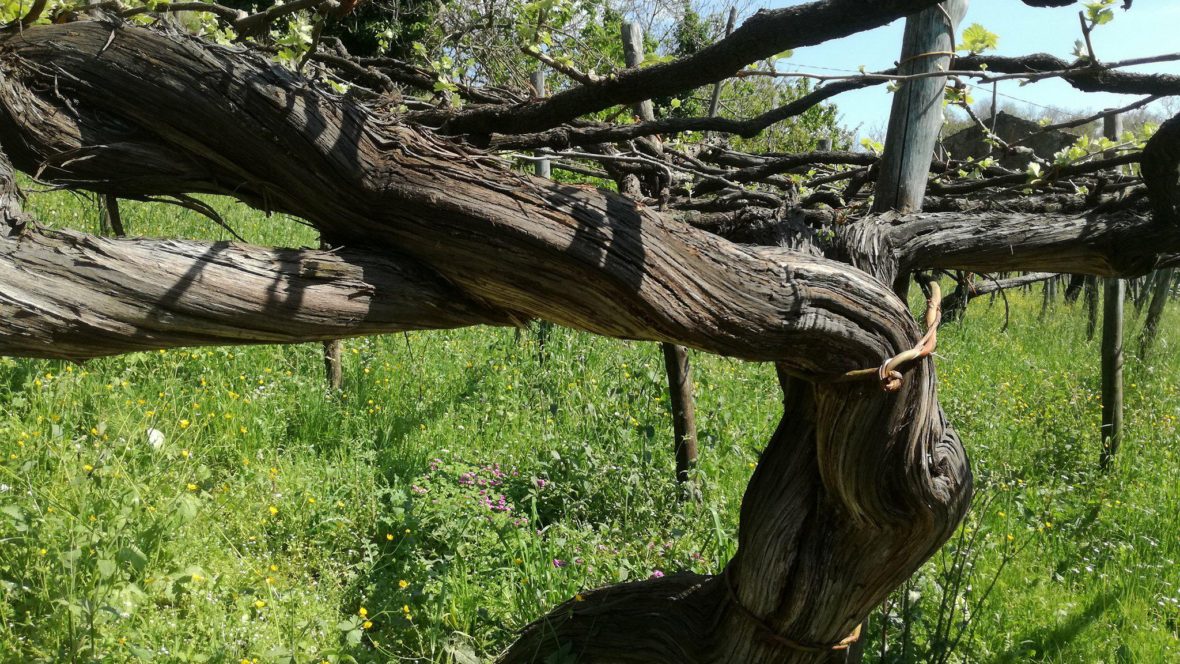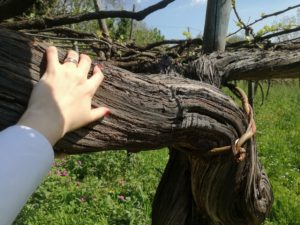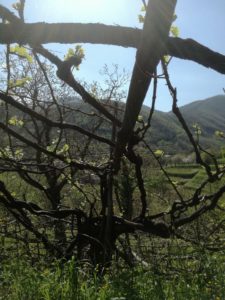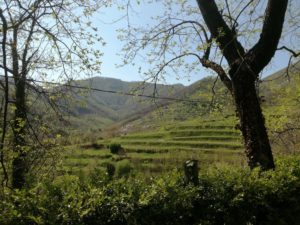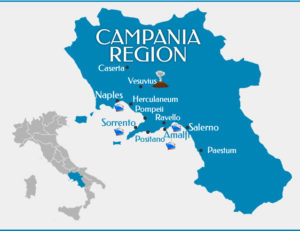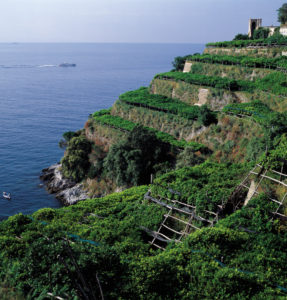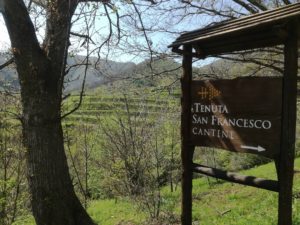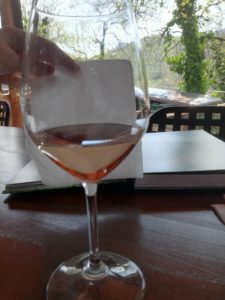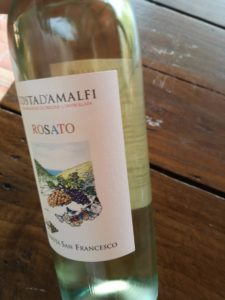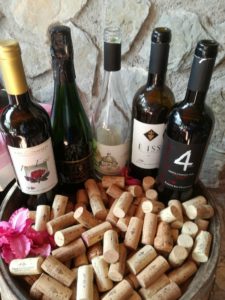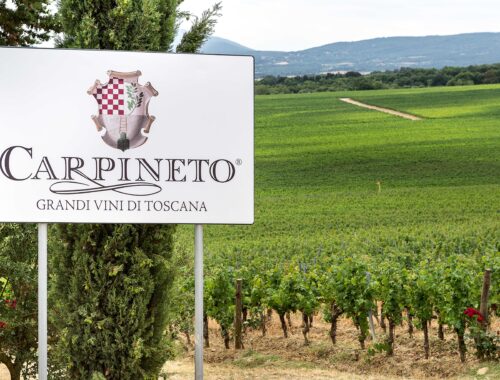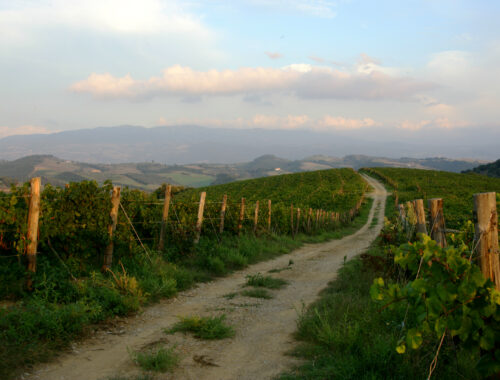When you get in front of a very old vine (see pic) you live a rare experience because of that damned insect, the phylloxera, which between the end of the 19th century and the beginning of the 20th one has changed the history, even better, the roots of the European vineyards which are now, almost the all of them, grafted on American roots.
So, when you find an ungrafted one, you “hail as a miracle”: the miracle is that they survived for so long against any adversity, a miracle that overcomes any expectation and human limit. Vines grasped to life as their own shape demonstrates (see pic).
This is why the motto of Tenuta San Francesco winery, located in the breath-taking Costiera Amalfitana, is: “the wine made from old vines is a miracle”. Here, the vines that survived to phylloxera are right those of Tintore, the local and typical red of Amalfi Coast and, more specifically, of its sub-area Tramonti, where we are. “It is him” the prince of the area as the label of the wine produced by Tenuta San Francesco, in local dialect, says “È Iss” (It’s him): a provocative name chosen by this winery when, lately, has risen sort of trend that pushed many producers to bring it back. But “it is him”, the one located right here, the original one; it’s him that has survived for so long and especially to phylloxera thanks to the volcanic soil composition, the surronding valley which protected it as well as the local and proud culture aimed to preservation.
Little to add, if not some useful information.
We are in the north of the province of Salerno in Campania region, south of Italy (see map). The area is covered by the appellation DOP Costa d’Amalfi and IGP Colli di Salerno.
A wonderful wine area which can surely be defined “heroic” because of the terraces overlooking the sea like cliffs with tremendous slopes.
The soils are mainly chalky and of dolomitic origins with presence, for example here at Tenuta San Francesco, of clay. The micro-climate conditions vary sensibly distinguishing each single terrace: the altitude can vary from some m a.s.l. up to 500/600 m a.s.l. with different exposures, ventilation, diurnal range which has brought the local regulation to identify (at least) 3 sub-areas:
- this one: Tramonti, the most planted with high altitudes and more similar to the inland (Irpinia and Sannio areas)
- Then there is Ravello (cool with good altitudes and mainly white wines)
- and Furore (with an important exposure but also ventilated).
The grape varieties of Amalfi coast are very numerous although the small size of the area, but the most common ones are:
- REDS: aglianico, piedirosso, tintore, sciascinoso
- WHITES: falanghina (and its clone, here called biancazita), biancolella (and its clone, here called biancatenera), ginestra, fenile, ripoli, pepella.
-
Tenuta San Francesco: intro
Tenuta San Francesco winery has been founded in 2004 by 3 families who used to sell their grapes and that year had a lot of unsold grapes to be transformed. Today they have about 12 Ha (for well 28 vineyards), half of them made of centuries-old vines (mainly of Tintore and Piedirosso) with their typical training system “pergola”; the other half, of about 30 years, with a vertical system. The cellar is dated back from the 18th century and made of limestone and pumice, the same pumice we can see on the surface of their vineyards. The whites are vinified in steel, the reds mature in wood: French oak tonneau or big barrels. They have a consultant (wine-maker): Valentini.
-
The wines of Tenuta San Francesco
TRAMONTI BIANCO 2017 (white made of: Falanghina, Biancolella, Pepella):
this is the first wine they have produced. The bouquet is intense and mature, but only with this warm vintage, otherwise prevails what is now just a ‘mineral’ vein (flint). Straight on palate, medium finish
PER EVA 2016 (white made of: Falanghina, Ginestra, Pepella):
Welcoming nose: white fruits, broom, sugared almond, white pepper and sulfur. Full, very savoury with a beautiful finish
PER EVA 2013 (magnum)
Absolutely coherent with the youngest brother, still sulfur but with a tertiary character. Imposing taste, still fresh with a smoke note on the finish
COSTA D’AMALFI ROSATO 2017 (rosè: Piedirosso, Aglianico)
The colour is so clear that I struggle to make a pic. The same “lightness” I find during the tasting: wild berries and sage, simple and balanced
ED 2017 (a new rosè version with a slightly higher percentage of the stronger Aglianico, Piedirosso)
Light pink in color. Rose on the nose, where it is also vegetal. Fine and delicate
TRAMONTI ROSSO 2015 (red made of: Tintore, Aglianico, Piedirosso)
Primary and crunchy nose: cherry, coffee, ash. Daily wine with personality, fruity and lively.
“4 SPINE” TRAMONTI ROSSO RISERVA 2015 (red: Aglianico, Tintore, Piedirosso)
Dense with a spicy character and then prune, licorice, paprika and a boisè character which needs to be better integrated as also demonstrated on the palate where is looking for a major harmony
“4 SPINE” TRAMONTI ROSSO 2010 (Aglianico, Tintore, Piedirosso)
Penetrating bouquet with balck pepper as well as kirsch and charred wood. The tannic structure of Aglianico is evident but balanced
È ISS 2014 (100% Tintore)
Vegetal on the nose with hints of licorice roots, ink, dark fruits. On the palate is lively, medium body, blueberry on the finish
È ISS 2010 (100% Tintore)
Deep Ruby with a “dark” imprint: wild fruits, pepper, tobacco and finally hints of eucalyptus. The body is not that strong, the acidity makes it lighter still keeping its “close” character.



